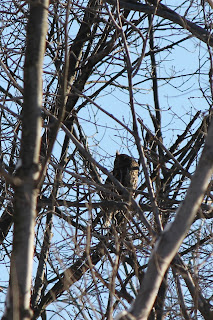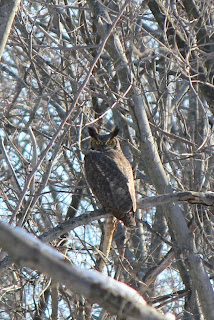What this means is that the inhabitants of this forest oasis will sometimes visit, or get close enough for me to connect with--and it's always special when that happens.
An Owl Flies Overhead
One night, in the fall of 2004, a few weeks after we moved into our house, my family gathered on our deck to witness a lunar eclipse. As we were out there in the cold, looking skyward, the silent silhouette of an owl flew just above us. It was an awesome moment, solidifying my love for this place, nature lover that I am.
We've seen fox and coyotes, deer and flying squirrels. We've seen evidence of raccoons, and had close--and smelly!--encounters with skunks. Birds of all kinds come to our feeders: woodpeckers, finches, sparrows, cardinals and hummingbirds. And of course, the hawks come to feed in turn on the birds.
Whoos in the Distance
But we've never seen owls. Over the years, every once in a while, we hear them. We've heard the eerie and indescribable calls of screech owls; those are the prototypical sounds encountered in the movies when the characters are lost and alone in dark scary forests. You can listen to an example or two on the Cornell Ornithology Lab's website; hearing them in person on a dark and lonely night has actually given me goosebumps.
More often, however, on a cool starry night, we'll be treated to the calls and responses of Great Horned Owls. When I hear them, I am reminded of one of my favorite children's books, Owl Moon by Jane Yolen. The story, which reads more like a poem, is about a father taking his young daughter out owling on a cold winter night. He calls out like an owl, and is rewarded with a response; eventually, they see the owl himself. I read this book to my kids so many times, I could just about recite it by heart--and I've given it as gifts to many a child because I love the story so.
And when I hear the sound of Great Horned Owls in my woods, I call out to them, like the father in the book. And nearly always, they respond. Call and response. Call and response. Sometimes my son will join me and he'll call out, too.
Am I am thrilled every single time. I feel like I've been given a very special gift--the ability to connect with another creature, even if all I'm doing is repeating its call.
But I've never seen one of these awesome creatures. I know they're there. I've heard them. I've communicated with them. But not a single sighting.
Until last week.
The Forest Calls to Me
On any given day, I'm likely to take a quick walk through our woods--a five or ten minute walk around our path, camera in hand. Sometimes I'm inspired by the lighting, or by a bird call, or a heard of deer. Sometimes I just need to plug in; the forest rejuvenates me in ways nothing else can.
 |
| Wren, calling me to follow it into the woods. |
At first, I couldn't find the wren, and as I was looking, a large bird-shaped shadow passed over the snow-covered ground. I looked up in time to see a sizable creature flying through the trees. When it landed on a branch a few hundred yards from where I stood, I took that as an invitation to a portrait session, and followed, camera in hand.
Within a minute or so, another large bird flew overhead, settling near the first. I couldn't tell what they were: hawks? vultures? I stared into the tangled limbs high above and ahead of me, and soon made out the silhouette of a bird.
I started snapping pictures, trying to focus between the branches.
 |
| There he is, but what is he? |
I'd take a few pictures, walk a couple dozen steps forward, snap a few more.
 |
| Still can't figure out who it is, the the short tail is a hint. |
I walked to the right, in a different direction, hoping to find a better perspective.
 |
| Too many branches in the way. But look at those ear tufts. |
Owl Take You For A Hike
When I had a clear view, I began to suspect I was looking at owls--specifically Great Horned. This was a huge thrill for me, so I just kept taking pictures. I tried to get closer, but first one, then the other would fly away--not too far, though. I was wondering if there was a nest nearby, but didn't see one. But it did seem to me that the birds were very deliberate in their flights.
They led, I followed.
This silent chase lasted about twenty minutes. I didn't feel the cold. It was me, my camera and the birds; was aware of very little else as I watched them fly and tried to follow them with the camera, clicking away.
And then they were too far for me to follow, and I walked back to the house, hoping that when I downloaded my shots, they would show me my owls.
I walked into the house a bit breathless, stopping long enough to remove coat, hat, gloves in a flurry. I removed the disk, from my camera, inserted it into my MacBook, and waited.
I clicked Download New Photos, and the magic began. Many of the pictures were blurry, with perfectly focused branches and smudgy suggestions of owls behind.
Some were too far away.
 |
| You can see the ear tufts quite clearly here. |
And in some, my subject wasn't cooperating; owls can rotate their heads as much as 270 degrees, so it's easy enough for one to remain motionless in body, but turn away in an slow arrogant huff.
 |
| Looking toward me. |
 |
| Turning away |
 |
| And facing the opposite direction, |
 |
| This is better; but there are way too many branches in the way. |
The pictures I took of the birds in flight were, for the most part, blurry sweeps of somewhat recognizable forest. Or a bit of a wing barely in the frame.
 |
| The back half of an owl. |
But when all was said and downloaded, and when I zoomed in on a few of the better shots, I wound up with two pictures I love, each featuring a gorgeous, recognizable Great Horned Owl.
 |
| Here's lookin' at you, human. |
And my favorite...pure serendipity. I have no idea how I managed to capture this phenomenal creature in full flight.
 |
| Simply. Gorgeous. |








































